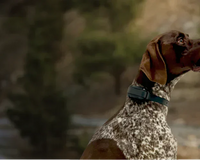Training a rescue dog is one of the most rewarding and potentially challenging tasks you will ever undertake. However, training a rescue dog is different from training a puppy; generic dog training advice often won't yield positive results.
You need to tailor your training to your rescue dog and manage your expectations to achieve success. We answer common questions about rescue dogs and explain how to begin training so you can bond with your new furry friend quickly.
Is it Hard to Train a Rescue Dog?
This question doesn't have a definitive answer; it depends on the dog, the breed, its previous experiences, the level of training it had before adoption, and if the rescue centre influenced its personality.
Training a rescue dog can be challenging, but it can also be easier than expected. It all depends on the dog you rescue and your dog training expectations.
How Long Does it Take a Rescue Dog to Adjust?
The time it takes for a rescue dog to adjust varies. Have empathy for rescue dogs; they have been taken from their first (or even second) home and moved to a rescue centre.
They lost whatever routine they had and were placed in a new environment with many new dogs. Then, you adopt them and take them to another new place.
They need to get used to a new routine, home, bed, and learn how to communicate with you. It will take at least a week for your dog to adjust to all these changes.
Tips for Helping Your Rescue Dog Adjust:
- Create a calm environment for your new dog and minimise the number of toys and people they interact with initially to avoid overwhelming them.
- Ensure they sleep in their designated sleeping spot.
- When introducing your new rescue dog to family members, let the dog approach them first.
- Whimpering through the night is normal; sleeping in a new place can be scary.
- Limit their access to space to avoid overwhelming them.
- Take them out to the toilet before bed to help avoid accidents.
- If the rescue had a routine that suits your lifestyle, try to stick with it. Familiarity will benefit your new rescue dog.
- Ideally, be home and not away at work for the first few days. Spending time together initially helps you get to know your new dog, and they get to know you while adjusting.
- If you know they are lead trained, walk them around their new neighbourhood but keep them on the lead for now.

How Do You Start Training a Rescue Dog?
First, identify any behavioural issues your dog has. This helps in starting your training efforts. Your shelter should provide behavioural traits/history on your new rescue dog.
Let's go through common behavioural issues that rescue dogs often have.
1. Food Aggression
Dog food aggression is when a dog shows hostility when someone approaches its food. The goal is to teach them that if someone approaches their food, it's a neutral or positive experience.
Training involves walking past while they eat, dropping tastier food into their bowl, and teaching them to wait for your command to eat.
2. Jumping Up On People
When a dog jumps up, it's their way of saying “hello, I’m happy to see you!”
For humans, this can be annoying and potentially dangerous. To train this behaviour out, you need patience as it’s usually an ingrained habit.
Do not reward your dog with attention when they jump. Turn around and ignore the dog until they greet you without jumping. We have an entire blog on it here, explaining how to train them to stop jumping.
3. Excessive, Nuisance Barking
If your rescue dog barks excessively, this could be the reason they ended up in a shelter. You're their new chance to learn better behaviour for a peaceful coexistence.
We’ve put together a collection of tips on excessive barking, as it’s a primary concern for many dog owners. To train this out, exhaust them physically, keep them stimulated, and block triggers from their view.
4. Separation Anxiety
Teaching your new rescue dog not to have separation anxiety when you're gone is challenging and requires trust and desensitisation.
Desensitise your dog to your comings and goings. Grab your keys randomly, so they don’t link the sound with you leaving. Avoid making a big fuss when entering or leaving; your presence should be no big deal.
Gradually increase the time you are away, and ensure your dog has plenty to do while you're gone. Enrichment toys like puzzle games and KONG toys will keep them busy.
5. Aggression
Dog aggression is often caused by fear and anxiety. It can lead to reactive behaviour, and they may bite or snap when they can't control their reactions.
If your rescue dog shows aggression, first visit the vet to rule out medical issues causing pain. If medically clear, explore why they’re aggressive and work on desensitising them to that trigger.
There are different stages of aggression, and many ways to manage it. Learn more about dog aggression.
6. Escaping
A rescue dog that escapes is usually scared, anxious, or frustrated.
First, ensure they can't escape. Increase your fence’s height and secure your property. Then, try to identify their triggers.
If they try to escape after you leave, it might be separation anxiety. If it’s due to frustration, they may also destroy other things.
Provide enriching toys and activities to tire them out physically and socially. Keeping them engaged will be essential.
7. Obedience Training
Obedience training is a must, even if your rescue dog knows some basic commands. Solidifying this training will make your future interactions smoother and faster.
You may also use different commands than their previous owner, so retrain them with your communication style.

Common Mistakes People Make When Training a Rescue Dog
Many common mistakes occur when training a rescue dog, often due to being too strict, too relaxed, or overwhelming the dog.- Don’t introduce your new rescue dog to other pets immediately; give them a few hours to settle in before making introductions.
- Educate children and adults on how to interact with a dog safely. Read up on safe interaction tips.
- Allowing the dog to misbehave because you feel bad about their past won't help you or the dog in the long run.
- Limit their space initially, letting them settle in a confined area before gradually increasing their access.
- When walking, ensure people don’t approach your new rescue dog suddenly and keep them on the lead until you’re confident in their behaviour.
If you encounter problems training your rescue dog, consult your vet or a behavioural specialist.
To stay updated on dog training, sign up for our newsletter. We provide regular tips, tricks, and hacks to help you and your furry friend live in harmony!











